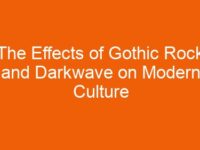-
Table of Contents
Influence of 90s and 2000s J-Rock and Visual Kei Fashion Trends
The influence of 90s and 2000s J-Rock and Visual Kei on modern culture extends beyond just music. One of the most notable impacts of this era of Japanese rock music is the fashion trends that emerged and continue to be popular today. The unique and bold styles of J-Rock and Visual Kei artists have left a lasting impression on fashion enthusiasts around the world.
During the 90s and 2000s, J-Rock and Visual Kei artists were known for their extravagant and flamboyant fashion choices. From elaborate hairstyles to dramatic makeup and eye-catching accessories, these musicians pushed the boundaries of traditional fashion norms. Their bold and edgy looks often incorporated elements of punk, goth, and glam rock, creating a distinct and rebellious aesthetic that resonated with fans.
One of the most iconic fashion trends to emerge from this era was the visual kei style. Characterized by elaborate and theatrical outfits, visual kei fashion often featured a mix of Victorian-inspired clothing, leather and lace, and bold patterns and colors. Artists like X Japan, Dir en Grey, and Malice Mizer were known for their elaborate costumes and extravagant stage presence, which helped popularize the visual kei style both in Japan and abroad.
Another key influence of 90s and 2000s J-Rock and Visual Kei fashion is the androgynous look that many artists embraced. Male musicians often wore makeup, styled their hair in unconventional ways, and wore clothing that blurred the lines between masculine and feminine. This gender-bending aesthetic challenged traditional notions of beauty and masculinity, inspiring fans to experiment with their own style and express themselves freely.
The impact of 90s and 2000s J-Rock and Visual Kei fashion can still be seen in modern culture today. Many contemporary artists and fashion designers continue to draw inspiration from the bold and unconventional looks of this era. The androgynous style popularized by J-Rock and Visual Kei artists has become more mainstream, with celebrities like Harry Styles and Billie Eilish embracing gender-neutral fashion and pushing the boundaries of traditional gender norms.
In addition to influencing mainstream fashion, the legacy of 90s and 2000s J-Rock and Visual Kei can also be seen in subcultures like goth, punk, and cosplay. Fans of these genres often draw inspiration from the extravagant and theatrical looks of J-Rock and Visual Kei artists, incorporating elements of these styles into their own fashion choices. The DIY ethos of J-Rock and Visual Kei fashion, which encouraged fans to experiment and express themselves creatively, continues to resonate with subculture communities today.
Overall, the impact of 90s and 2000s J-Rock and Visual Kei fashion on modern culture is undeniable. The bold and unconventional looks of J-Rock and Visual Kei artists have inspired a new generation of fashion enthusiasts to embrace individuality, creativity, and self-expression. As we continue to see the influence of this era in contemporary fashion trends, it is clear that the legacy of J-Rock and Visual Kei will continue to shape the way we think about style and identity for years to come.
Impact of J-Rock and Visual Kei Music on Contemporary Music Scene
The 90s and 2000s were a transformative time for Japanese rock music, with the rise of J-Rock and Visual Kei bands making a significant impact on the music scene both in Japan and around the world. These genres brought a unique blend of rock, punk, and pop influences, along with flamboyant fashion and theatrical performances that captivated audiences and left a lasting impression on modern culture.
One of the key effects of J-Rock and Visual Kei on contemporary music is the way they pushed boundaries and challenged traditional notions of what rock music could be. Bands like X Japan, L’Arc~en~Ciel, and Dir en grey fused elements of metal, punk, and pop with a distinctly Japanese sensibility, creating a sound that was both familiar and new. Their music was characterized by intricate guitar riffs, powerful vocals, and dynamic arrangements that set them apart from their Western counterparts.
In addition to their musical innovations, J-Rock and Visual Kei bands also made a splash with their flamboyant fashion and theatrical performances. Visual Kei bands like Malice Mizer and Versailles embraced elaborate costumes, makeup, and hairstyles that blurred the lines between gender and challenged conventional ideas of beauty. Their live shows were equally theatrical, with elaborate stage sets, choreography, and pyrotechnics that created a sense of spectacle and drama.
The impact of J-Rock and Visual Kei on contemporary music can be seen in the way that these genres have influenced a new generation of artists and bands. Many Western musicians have cited J-Rock and Visual Kei as a major influence on their work, with artists like My Chemical Romance, Panic! At The Disco, and Bring Me The Horizon drawing inspiration from the theatricality and emotional intensity of these genres. In Japan, bands like One Ok Rock and Babymetal have taken up the mantle of J-Rock and Visual Kei, blending elements of rock, metal, and pop with their own unique twist.
Beyond the music itself, J-Rock and Visual Kei have also had a lasting impact on fashion, art, and popular culture. The flamboyant style of Visual Kei bands has inspired fashion designers, makeup artists, and photographers around the world, with their bold colors, intricate patterns, and avant-garde aesthetics becoming a staple of street style and high fashion alike. In addition, the themes of rebellion, individuality, and self-expression that are central to J-Rock and Visual Kei have resonated with fans of all ages and backgrounds, creating a sense of community and belonging that transcends borders and boundaries.
In conclusion, the effects of 90s and 2000s J-Rock and Visual Kei on modern culture are undeniable. These genres have pushed boundaries, challenged conventions, and inspired a new generation of artists and fans to embrace their creativity and individuality. From their innovative music to their flamboyant fashion and theatrical performances, J-Rock and Visual Kei have left an indelible mark on contemporary music and popular culture that continues to resonate to this day.
Evolution of Visual Kei Subculture in the Digital Age
The evolution of Visual Kei subculture in the digital age has been a fascinating journey that has left a lasting impact on modern culture. Visual Kei, a subgenre of Japanese rock music that emerged in the 1980s, has continued to evolve and influence various aspects of society, particularly in the realms of fashion, art, and music. The 90s and 2000s were pivotal decades for Visual Kei, as the genre gained international recognition and a dedicated fan base outside of Japan.
During the 90s and 2000s, Visual Kei bands such as X Japan, L’Arc~en~Ciel, and Dir en grey rose to prominence both in Japan and abroad. These bands were known for their flamboyant and elaborate visual styles, which often included elaborate costumes, heavy makeup, and extravagant hairstyles. The music itself was a fusion of various genres, including rock, metal, punk, and pop, creating a unique sound that captivated audiences around the world.
One of the key factors that contributed to the popularity of Visual Kei in the 90s and 2000s was the rise of the internet and social media. Fans were able to connect with each other and with their favorite bands through online forums, fan sites, and social networking platforms. This sense of community and camaraderie helped to spread the influence of Visual Kei beyond Japan’s borders, leading to an increase in international fan base.
The fashion of Visual Kei also played a significant role in its evolution during this time period. The flamboyant and gender-bending styles of Visual Kei bands inspired a new wave of fashion designers and enthusiasts who embraced the subculture’s bold and unconventional aesthetic. Elements of Visual Kei fashion, such as elaborate costumes, leather accessories, and dramatic makeup, became popular in mainstream fashion and streetwear, influencing trends in both Japan and the West.
In addition to music and fashion, Visual Kei also had a profound impact on the art world during the 90s and 2000s. The genre’s emphasis on visual aesthetics and theatrical performances inspired a new generation of artists who incorporated elements of Visual Kei into their work. Visual Kei’s influence could be seen in various art forms, including photography, graphic design, and performance art, creating a vibrant and dynamic cultural landscape that blurred the lines between music, fashion, and visual art.
As we look back on the evolution of Visual Kei subculture in the digital age, it is clear that the genre’s impact on modern culture is undeniable. The 90s and 2000s were transformative decades for Visual Kei, as the genre gained international recognition and a dedicated fan base outside of Japan. Through its unique blend of music, fashion, and visual aesthetics, Visual Kei continues to inspire and influence artists and audiences around the world, leaving a lasting legacy that transcends borders and generations.





















0 Comments